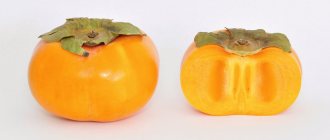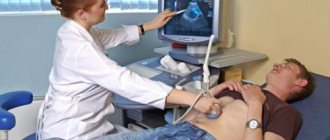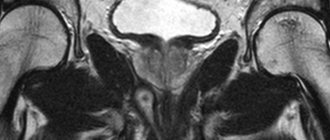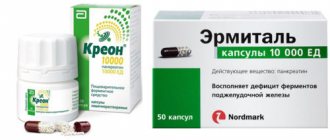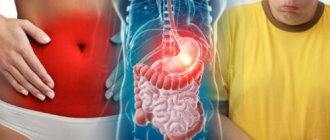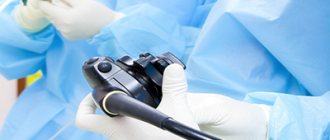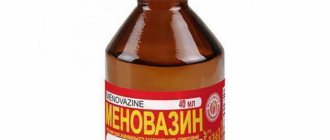Author
: Grachev Ilya Illarionovich
Editor
: Efremov Mikhail Mikhailovich
Publication date: 05/13/2014 Update date: 12/16/2021
The role of the pancreas in the life of the human body is difficult to overestimate. It is she who is responsible for organizing digestion and regulating energy metabolism. And it is very important that this organ is healthy and functioning correctly. Therefore, if you suspect pancreatitis, you should immediately consult a doctor.
A set of diseases accompanied by inflammation of the pancreas is called pancreatitis. This disease requires timely treatment, since when the gland becomes inflamed, the enzymes produced by the gland are not released into the duodenum. They are activated in this organ, which gradually destroys it and damages other vital organs (liver, lungs, brain, etc.).
Causes of pancreatitis
Among the main causes of pancreatitis, alcohol abuse is the first to be mentioned. More than half of the cases of this disease occur as a result of regular consumption of alcoholic beverages. In addition, among the causes of pancreatitis are:
- cholelithiasis, diseases of the duodenum, gastric surgery;
- infections and viruses that cause mumps, hepatitis B, C, etc., abdominal injuries (wounds);
- taking certain medications;
- poor nutrition;
- predisposed heredity, etc.
Contraindications
In addition to the benefits of prostate massage for men, you should also know the contraindications to the procedure. The decision on its appropriateness is made by the attending physician, assessing the overall clinical picture, existing limitations and the expected effect of the manipulation.
Contraindications:
- acute inflammatory process in the gland;
- tuberculosis;
- prostate cancer;
- acute urinary retention;
- proctological pathologies (hemorrhoids, anal fissures);
- adenoma;
- established neoplasm or stones in the gland;
- inflammatory processes in the rectum.
Symptoms of pancreatitis
In the presence of an acute form of the disease, the main symptoms of pancreatitis are:
- severe girdle pain in the upper abdomen;
- stool disturbance (becomes oily and liquid);
- swelling of the eyelids;
- redness of the skin;
- the appearance of a dry coating on the tongue (the tongue is thickened);
- swelling of the feet;
- the appearance of red spots on the palms;
- severe nausea and vomiting;
- weakness etc.
With chronic pancreatitis, the patient experiences:
- the occurrence of pain 40-60 minutes after a heavy meal (especially spicy and fatty);
- girdle pain in the epigastric region, radiating to the left (right) hypochondrium and back;
- copious mushy stools with particles of undigested food;
- increased sweating, nausea, flatulence, loss of appetite, sudden weight loss of the patient, etc.
Severity
Acute pancreatitis, the treatment of which is very difficult, can occur in various forms. The disease is classified depending on the severity:
- The mild form is characterized by the fact that the organ continues to function with minimal impairment. In this case, during instrumental examinations, slight swelling is detected.
- The average form causes complications of a necrotic nature. Against the background of organ failure, malfunctions occur in the functioning of other systems in the human body.
- The severe form is characterized by destruction by a strong inflammatory process, which often leads to purulent infected tissue necrosis. This can damage nearby organs.
Treatment methods for pancreatitis
The effectiveness of treatment of pancreatitis directly depends on the chosen methods. Today, the main methods of treating pancreatitis are:
- Acupuncture - allows you to restore the basic functions of the pancreas, neutralize spasms, relieve acute pain and inflammation.
- Acupressure – allows you to eliminate inflammation of the gland, increase immunity, eliminate spasms, pain; performed on biologically active points.
- Moxotherapy – bioactive points are heated with the help of wormwood cigars.
- Herbal medicine helps to normalize the functioning of the pancreas.
- Individual therapeutic diet: provides selection of nutrition taking into account the form of the disease.
Treatment of pancreatitis at the Paramita clinic
Do you want to forget once and for all about what pancreatitis is? The Oriental Medicine Clinic is at your service! Our specialists use an integrated approach to the treatment of pancreatitis and other diseases. Each patient who turns to us for help undergoes a thorough preliminary examination, on the basis of which a diagnosis is made and an individual course of treatment is selected.
When treating pancreatitis, we use Tibetan medicine methods, which allows us to quickly and effectively eliminate pancreatic disease. In 4-10 sessions, the functions of the organ are completely restored, and the functioning of other vital organs is stabilized.
Techniques used when massaging the abdomen
Abdominal massage is done very carefully so that the patient does not experience discomfort or pain. The time for massaging this area should not exceed 8-10 minutes.
In therapeutic massage, which is performed for diseases of the digestive system, the specialist uses all the techniques of classical massage. Such techniques include: stroking, rubbing, kneading, striking techniques, vibration and active-passive movements.
- Stroking . In order for the patient’s abdominal area to completely relax, the massage therapist, using his palms, very gently and carefully, performs stroking movements from the middle of the sternum to the groin area. There are several types of stroking movements: S- and V-shaped, zigzag and rake-shaped, transverse and straight, forceps and comb-shaped. As for the execution technique, stroking can be done with the pads of the fingers, the bases of the palms and directly with the palms.
- Rubbing . When massaging the abdominal area, the master can use several types of rubbing. For example, he can work with the palms and phalanges of the fingers, the pads of the thumbs, the pads of the four fingers, or the index and middle fingers. The supporting part of the hand is not used by the massage therapist during the rubbing process, since the proximity of the internal organs to the skin allows for a superficial (without pressure) rather than a deep massage.
- Kneading . There are several different kneading techniques that help improve the functioning of not only internal organs, but also the entire body. As a rule, the master begins kneading by using basic techniques - longitudinal (along the muscle fibers) and transverse kneading. Kneading techniques also include shifting and twitching.
- Impact techniques . When performing an abdominal massage, the massage therapist can use percussive techniques such as patting, tapping, and puncturing. Chopping is a technique characterized by great sharpness, so it is completely excluded for this zone.
- Vibration . In massage techniques, there are two types of vibration: intermittent and continuous. When massaging the abdominal area, the specialist uses both of these types of vibrations, and to perform them he uses only his fingers. As for the rate of vibration, the master chooses it, taking into account the patient’s condition.
Stages of pancreatitis
- The enzymatic phase lasts up to 5 days and means partial necrosis of part of the organ. The body is poisoned by enzymes. May be accompanied by pancreatogenic shock, renal or liver failure. High probability of death.
- The reactive phase follows the one described, when the body tries to adapt to the current situation and filter out toxins. They accumulate in tissues with blood and lymph. The duration of this phase is up to 12 days.
- The sequestration phase, during which the dead area (sequestrum) is separated. It releases toxic substances that negatively affect internal organs.
- Outcome phase - begins 6 months after the attack.
The essence of massage according to the Old Slavonic method
According to healers, inflammation of any organ is accompanied by paresis of nerve tissue and severe vascular spasms. The result is a lack of oxygen and nutrients reaching the diseased organs. Stagnation begins in the venous and lymphatic system, during which the products of the activity of pathogenic microorganisms are simply not excreted.
If you do visceral massage of internal organs correctly, using specially developed technology and courses, you can speed up the healing process, because the cells of diseased organs will receive sufficient nutrients.
The specialist makes deep pressure on the abdomen, his hands are positioned at a certain angle and act on a specific internal organ. There are techniques that will help alleviate the patient’s condition even with osteochondrosis. An excellent result after visceral cupping massage, namely, improved blood and lymph circulation, increased immunity and tone, elasticity of the skin, makes the procedure useful and, if necessary, to get rid of cellulite and excess weight.
Diagnosis of pancreatitis
In our clinic, doctors conduct diagnostic examinations using the best achievements of Western and Eastern medicine.
- Primary visual diagnosis. By assessing the patient’s behavior, gaze, breathing and appearance, the doctor determines the nature and extent of the problem within the first minutes of contact.
- Survey. The conversation with the patient is based on certain questions that allow the doctor to determine the state of the body at the energy level. In Eastern medicine, the technique is called fine-tuning the body.
- Inspection. This stage is carried out using effective Eastern and Western techniques for examining the patient. It allows you to find out the whole picture of the patient’s general condition, identify the root cause of the disease, and detect hidden symptoms and concomitant diseases.
- Pulse diagnostics. The method has become widespread in Chinese and Tibetan medicine due to its ability to accurately make an accurate diagnosis.
Additionally, doctors prescribe hardware and laboratory tests.
Timely diagnosis allows you to establish the presence of the disease at an early stage, which will save you from serious problems later.
What are the benefits of prostate massage?
Since the procedure brings significant discomfort, many men wonder whether prostate massage is beneficial. Doctors highlight the following therapeutic effects from the procedure:
- removal of stagnant gland secretions;
- improving blood supply to organs;
- reduction of muscle tension in the prostate area;
- improvement of potency due to stimulation of the seminal fluid ducts;
- partial relief of symptoms of chronic prostatitis;
- reduction of pain during inflammation.
In addition, regular massage prevents prostate cancer, reduces the risk of benign hyperplasia, reduces the frequency of relapses of prostatitis, and has a beneficial effect on potency.
Diet for pancreatitis
- Consume only boiled, steamed and stewed food.
- Eliminate milk (you can only eat fermented milk products and low-fat cottage cheese).
- Only veal is allowed from meat, and low-fat types from fish.
- The basis of the diet can be porridge, pasta, and stewed vegetables.
- Minimize the consumption of sugar and salt.
Efficiency comes from a diet designed individually for the patient, taking into account all health problems. Doctors at our clinic give detailed recommendations on diet and foods allowed for consumption.
Indications for massage
Many men are concerned about the question: why do they massage the prostate? Traditional indications for the procedure are:
- chronic prostatitis;
- erectile disfunction;
- infertility;
- chronic pain in the pelvic area;
- treatment of bacterial prostatitis in combination with antibiotics (intensification of blood supply improves drug penetration).
Exercises
The best effect in the treatment of pancreatitis can be achieved by daily walks and special therapeutic exercises.
Examples of recommended exercises:
- Inhale, exhale, hold your breath. Smoothly draw in your stomach and after counting to 3, relax your muscles.
- Enter, exhale, hold your breath. Inflate your stomach strongly and after counting to 3, relax.
A full set of exercises is prescribed only by a doctor. We create an individual lesson plan for each patient.
What is abdominal acupressure?
This is also visceral therapy, but based on the Japanese technique. The specialist presses on certain points with his fingers, rather than using the entire palm. It is believed that this method can cure even serious pathologies of the abdominal organs without pills. Japanese acupressure of the abdomen improves the emotional state and normalizes hormone production.
This procedure has a number of features:
- The massage also begins with stroking, warming movements, and then the massage therapist begins to work on individual points, starting 2 cm above the navel.
- First, the specialist presses on points located close to the navel, and then on the palm from it.
- At the end, stroking movements are used again.
- During the massage, a small amount of oil is used, which is simply removed with a napkin after the procedure.
The course lasts no more than 3 weeks . The procedure must be carried out every day.
The effect of massage of different parts of the spine and the main contraindications
Various pathologies of the back lead to incorrect anatomical location of the vertebrae and muscles.
spine massage
Massage can have a restorative effect and form the correct bends and shapes of the areas of the spinal column. Only a qualified doctor can perform a proper spinal massage. It is especially important to choose a professional, because treatment is aimed at the rehabilitation of the musculoskeletal system, which is important for the body.
Massaging the thoracic vertebrae is usually prescribed to reduce the symptoms of neuralgia and degenerative tissue damage (osteochondrosis). Massaging the collar part of the body will help relieve severe headaches, restore blood circulation and reduce adynamia. As a pain reliever, massage is used when a hernia is detected between the vertebrae as an additional treatment.
Who needs a spinal massage
A sedentary and inactive lifestyle, so common in our modern world, has a very negative effect on the entire body. Also, due to heavy loads on the back, a person begins to feel pain in the lower back, cervical and thoracic areas, and incorrect posture develops. Therefore, negative manifestations in the back and even just tension are an important reason for massage effects.
Spinal massage will also be useful for those who have the following ailments:
- Curvature of the vertebrae (kyphosis, scoliosis), inferiority of the ligamentous apparatus;
- It will improve the process of maintaining the cartilage tissue of the spine in case of various herniated intervertebral discs, protrusions and various types of osteochondrosis;
- When it is necessary to strengthen the muscle group of muscles that support the spinal column;
- Lumbodynia – painful sensations in the lower back that are chronic;
- Thoracalgia is a painful deformation of different parts of the back;
- When the spinal roots are pinched;
- After surgery or serious injuries, massage will increase blood circulation in pinched tissues and strengthen them;
- Post-stroke and neuralgia
; - Swelling of body tissues after long periods of sitting or standing;
- Passing to the groin and thighs - pain in the gluteal muscles.
Restrictions on massage
A preliminary consultation with your doctor is required before performing the procedure. After all, this is not just a pleasant and relaxing procedure, it is one of the methods of treating and preventing problems of the spinal column. Everyone should remember about contraindications that arise temporarily or, as happens quite often, are permanent.
Temporary limiting factors:
- various bleedings (from the nose, uterus, intestines);
- for acute respiratory infections, flu, sore throat;
- complication of pathologies of internal organs;
- purulent diseases affecting the body;
- skin rash;
- sudden increase in blood pressure;
- osteoporosis – acute infection of the spinal column and joints;
- vomiting and nausea.
The permanent group includes:
- varicose veins;
- respiratory failure;
- the presence of a malignant tumor without initiation of treatment;
- active degree of tuberculosis;
- poor blood clotting syndrome;
- pathological dilatation of the aorta and heart vessels;
- STD;
- cardiovascular diseases;
- AIDS.
Next, let's talk about massage on various areas of the spinal column. The main thing you need to know: the impact should be carried out at a distance of three to ten cm on the right and left sides of the spinal column. The movements should be directed upward from the lower back to the beginning of the hair.
Massage of the lumbosacral region
The greatest load is placed on the lumbosacral region; it is almost never relaxed. That is why, in order to relieve severe and frequent pain in this area, a specialist must pay special attention to its treatment.
First you need to stretch the muscles of the buttocks and only then begin to work on the problem area. Stroking movements warm up the muscles in the pelvic area. Squeezing, kneading, shaking and stroking again - all actions alternate. Repeat two or three times.
At the next stage, squeezing is performed, and the massage therapist moves his fingers, folded into a fist, along the spine with kneading movements. Finally, stroking and shaking are done to calm the tissues.
Cervicothoracic massage
The neck is the most unprotected part of the human body, because it contains a large number of channels with nerves and blood vessels. Therefore, massage has an excellent effect in relieving neck movement restrictions.
The techniques used in this type are kneading, stroking, shaking, squeezing and rubbing. The right and left areas of the spine, reflexogenic zones and places of the spinal cord roots deserve special attention.
It is worth starting massage from the healthy side, that is, the opposite side to the one in which pain is present. The back and neck muscles should be in a state of complete relaxation - this is very important. The massage can be performed both in a sitting position and in a lying position.
DIY cervical massage
You can massage your cervical spine yourself while at home. It doesn't take long - less than 15 minutes. While sitting, you need to move from the fourth vertebra of the sternum to the beginning of the hair.
In self-massage, the same movements are used as in classic cervical massage.
You can make movements with two palms at the same time or just one. All actions must be correct and careful. It's better to see a doctor if you can't. This will reduce the risk of self-harm. Author: K.M.N., Academician of the Russian Academy of Medical Sciences M.A. Bobyr
Can I do the procedure at home?
There are various courses teaching visceral massage, which promise that after completing them you can do a similar practice at home. However, experts warn that self-medication can be dangerous. You shouldn’t try to do a visceral massage yourself using a couple of videos from the Internet. An incorrectly performed procedure can cause exacerbation of diseases and deterioration of well-being.
You can watch a video that explains in detail how massage is performed, why it is useful, what a specialist does and what effect you can expect. This will allow you to prepare for the procedure and understand the importance of a professional approach.
Acupressure or deep visceral massage, aimed at normalizing the functioning of internal organs, cannot be performed at home on your own. But you can do a regular lymphatic drainage massage using a special cream or oil. It consists of slowly stroking the abdomen clockwise without applying strong pressure. It is worth remembering that lymph moves slowly in the body, so movements should be leisurely. With the help of such a light massage, you can speed up the removal of fluid from the abdominal area, relieve swelling and tighten your stomach a little in a short time.
The technique of visceral massage is quite complex and powerful. It cannot be used without sufficient knowledge. It is better to entrust your health to a professional.
Action on the pancreas
At the stage of acute inflammation of the pancreas, any mechanical impact on the organ is contraindicated due to severe pain, nausea, vomiting, diarrhea and the person’s severe general condition. At this time, the patient should fast for the first 2-3 days, drink only clean water or rosehip decoction. Cold should be applied to the stomach and strict bed rest should be observed.
There can be no talk of any massage during exacerbation of the inflammatory process.
But when a chronic disease enters the remission phase, certain manual techniques significantly speed up the patient’s recovery. Massage has a number of positive effects in pancreatic pathologies:
- Spasm of smooth muscle organs (pancreatic ducts, gallbladder, common bile duct) occurs.
- The hepatic-duodenal and hepatogastric ligaments relax, which improves access for the massage therapist directly to the gland.
- Blood circulation and innervation of internal organs are restored.
- The outflow of pancreatic contents, as well as bile, improves. This prevents the development of cholecystitis, cholelithiasis, and treats dyskinesia of the biliary tract and intestines.
- The condition of the endocrine gland is normalized. This is especially important in pancreatogenic diabetes mellitus.
When massage is contraindicated and can harm a person
Despite the fact that massage has a positive effect on the patient’s condition, there are a number of factors in which it is strictly prohibited. If the patient has some pathological phenomena, it will do more harm than good.
Contraindications for it are:
- Acute phase of pancreatitis.
- The presence of ulcers in the pancreas.
- High body temperature.
- The appearance of skin rash during pancreatic relapse.
- Inflammation of the lymph nodes, including the cervical and submandibular ones.
- Presence of hypertensive blood pressure.
- State of alcoholic intoxication.
- Psychical deviations.
- Epilepsy with frequent exacerbations.
- Bleeding.
- Gynecological and venereal diseases.
- Oncology (massage increases blood flow, which promotes tumor growth).
- Presence of fatty tissues and fibroids.
- Presence of nausea with vomiting.
Therapeutic massage will benefit patients with gastritis, pancreatitis and kidney pathologies only in the complete absence of the above complications.



